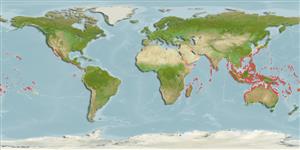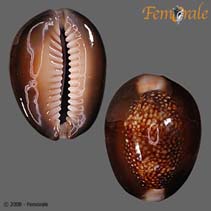Cypraea caputserpentis Linnaeus, 1758
Serpent's head cowrie| Native range | All suitable habitat | Point map | Year 2050 |

|
| This map was computer-generated and has not yet been reviewed. |
| Cypraea caputserpentis AquaMaps Data sources: GBIF OBIS |
Classification / Names Common names | Synonyms | CoL | ITIS | WoRMS
| Littorinimorpha | Cypraeidae
Environment: milieu / climate zone / depth range / distribution range Ecologia
. Tropical
Distribuição Países | Áreas FAO | Ecossistemas | Ocorrências | Introduções
Indo-Pacific: East and South Africa and eastern Polynesia.
Length at first maturity / Tamanho / Peso / Idade
Maturity: Lm ? range ? - ? cm Max length : 4.5 cm SHL macho/indeterminado; (Ref. 349); common length : 3.5 cm SHL macho/indeterminado; (Ref. 349)
Frequently collected throughout the Indo-Pacific, mainly for its shell which is used in local handicrafts (Ref. 349). Also found abundant in rock platforms exposed to wave action. Mainly active at night, crawling out of crevices and boulders, but can also be found in the open during the day. Shallow subtidal waters (Ref. 349); found from low tidal to shallow subtidal, in rock crevices (Ref. 337). Live specimens rarely found in rock-pools and among rocks near low-water mark (Ref. 88739). Members of the family Cypraeidae are primarily carnivores (Ref. 67623).
Life cycle and mating behavior Maturidade | Reprodução | Desova | Ovos | Fecundidade | Larvas
Members of the order Neotaenioglossa are mostly gonochoric and broadcast spawners. Life cycle: Embryos develop into planktonic trocophore larvae and later into juvenile veligers before becoming fully grown adults.
Referência principal
Referências | Coordenador | Colaboradores
Poutiers, J.M. 1998. (Ref. 349)
Status na Lista Vermelha da IUCN (Ref. 130435)
Status no CITES (Ref. 108899)
Not Evaluated
CMS (Ref. 116361)
Not Evaluated
Perigo para os humanos
Harmless
Uso pelos humanos
Pescarias: espécies comerciais
| FishSource |
Ferramentas
Mais informação
Fontes da internet
BHL | BOLD Systems | CISTI | DiscoverLife | FAO(Publication : search) | Fishipedia | GenBank (genoma, nucleotídeo) | GloBI | Gomexsi | Google Books | Google Scholar | Google | PubMed | Árvore da vida | Wikipedia (Ir para, procura) | Registro zoológico
Estimates based on models
Preferred temperature
(Ref. 115969): 24.6 - 29.3, mean 28.3 (based on 2865 cells).
Categoria de preço
(Ref. 80766):
Unknown.



